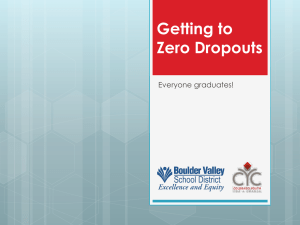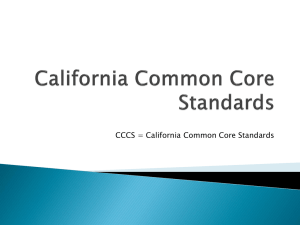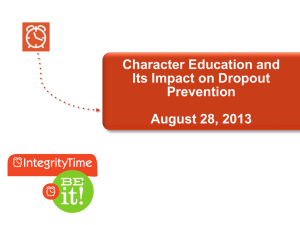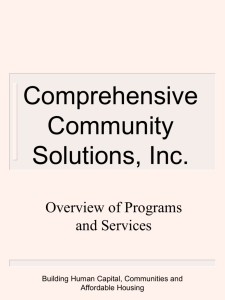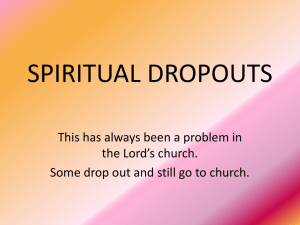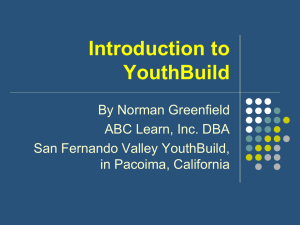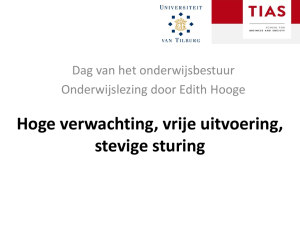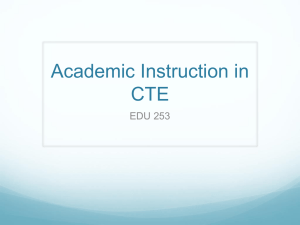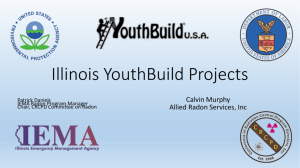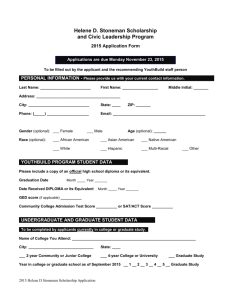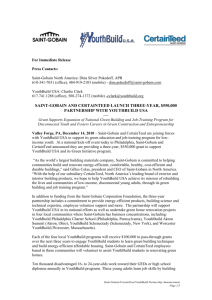A Different Type of High Quality - The Impact of Charter Schools On
advertisement
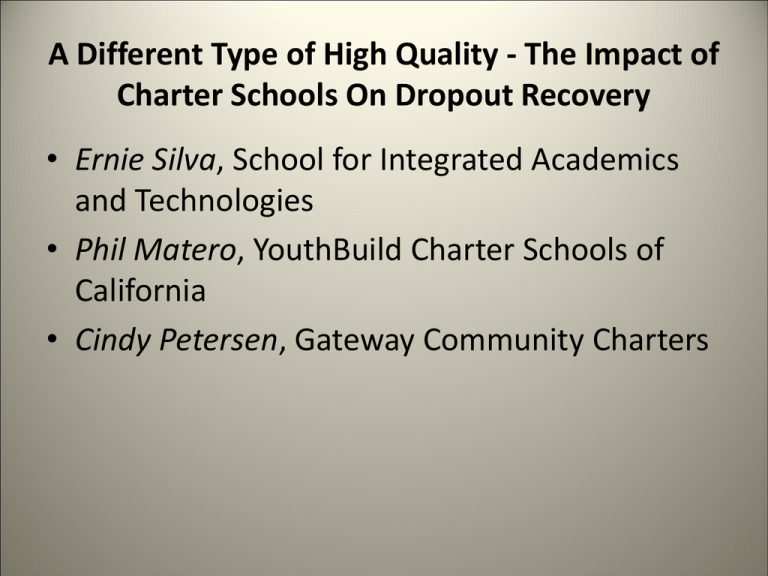
A Different Type of High Quality - The Impact of Charter Schools On Dropout Recovery • Ernie Silva, School for Integrated Academics and Technologies • Phil Matero, YouthBuild Charter Schools of California • Cindy Petersen, Gateway Community Charters A Different Type of High Quality The Impact of Charter Schools On Dropout Recovery Ernie Silva SIATech: School for Integrated Academics and Technologies The Importance of Dropout Recovery • “The hope of Brown v. Board has yet to be fulfilled, and the nation has a moral imperative to improve the educational outcomes of students of color and Native students.” • If only ½ of the dropouts from California’s Class of 2010 were recovered and graduated, they would earn an additional $1.4 Billion per year; invest an additional $394 million per year; spend $4.5 Billion more on home purchases; and generate $167 Million more in tax revenues each year. » Alliance for Excellent Education; www.all4ed.org The Importance of Dropout Recovery • “Despite considerable state progress in addressing dropout prevention, few state efforts exist to reengage dropouts and get them back on track to graduation. States have largely focused on dropout prevention because it is easier and cheaper to prevent a student from leaving school than to bring a dropout back to school. Yet, no matter how effective a state‘s dropout prevention efforts, students invariably fall through the cracks.” » (National Governor’s Association, 2011) The Importance of Dropout Recovery – ACR 57 SIATech Students California SIATech • American Indian/Alaskan Native 1% 2% • Asian 11% 5% • Black or African American 7% 26% • Hispanic/Latino 51% 53% • Native Hawaiian or Other Pacific Islander 1% 2% • Unknown 3% 1% • White 27% 12% How SIATech Reengages Dropouts • Accredited high school in partnership with Job Corps and other WIA related programs • Partners provide extensive reengagement services – job training, health services, food, housing, and more • Graduates earn job skills and a diploma in less than two years. • Highly Qualified Teachers. • Customized Professional Development: • RAPSA and BTSA Induction targeted to serve our students. How SIATech Reengages Dropouts • Our school accelerates learning – Competency-based not seat-time – Individual Learning Plan – High Tech/High Touch – Blended learning opportunities How SIATech Reengages Dropouts • Because students are far below grade level, traditional measurements don’t work – we’ve adopted growth model and have legislative support for its use in lieu of other measurements (AB 180) SIATech Outcomes Growth Model (AB 180) Article by Dr. Linda Dawson, Kris Mallory & Khristel Johnson in the Association of California School Administrators magazine in 2011. How SIATech Reengages Dropouts • Students not only earn diplomas and job skills but also participate in high level learning opportunities like Robotics and Legislative Internships SIATech Outcomes • • • • • Individual Student Growth Gallup Poll – Hope, Engagement and Well Being Graduation CAHSEE API – Ours has been above 900 for years SIATech Outcomes: Grad Rates SIATech Outcomes Ethnicity and Race SIATech Outcomes College Enrollment Ethnicity/Race Percentage of Total High School Graduates Enrolled in Postsecondary Institutions (3) Hispanic or Latino of Any Race 30.4 % Asian, Not Hispanic 31.7 % African American, Not Hispanic 42.5 % White, Not Hispanic 36.5 % Not Reported 46.2 % Total 35.1 % SIATech Robotics SIATech Legislative Internships Superintendent of Public Instruction, Tom Torlakson with the San Jose Team. SIATech Legislative Agenda School for Integrated Academics and Technologies SIATech Ernie Silva Director of External Affairs 1029 J Street, Ste. 310 Sacramento, CA 95814 Phone: (916)712-9087 E-mail: ernie.silva@siatech.org “ “ Each time a man stands up for an idea, or acts to improve the lot of others, or strikes out against injustice, he sends forth a tiny ripple of hope, and crossing each other from a million different centers of energy and daring, those ripples build a current which can sweep down the mightiest walls of oppression and resistance. – ROBERT F. KENNEDY History of YouthBuild Charter School of California (YCSC) • YouthBuild Charter School of California is one of the charter schools in California that benefits from the the Education Code exemptions that apply to YouthBuilds, Job Corps, conservation corps, and WIA funded programs. • All of our students are enrolled in a YouthBuild program, and we exist exclusively to provide an education for them. • Students can be overage, and we can operated throughout the State. continued… • The charter school was authorized and launched in 2008, opening initially at three YouthBuild programs--in East Los Angeles, Watts, and El Monte. • It then expanded to seven sites in its second year and to eleven in its third year. Now in its fourth year, YCSC provides the education component at 12 YouthBuild sites. • Student to teacher ratio averages 17:1. • It is a classroom-based school. YCSC Core Values • Philosophy of Education – YCSC students have the right to an authentic education that will prepare them to counter social inequities and become leaders in their communities. • Project-Based Approach – YCSC students have the right to be creators of new knowledge in an engaging and contextualized project-based curriculum. • Post-secondary Opportunities – YCSC students have the right to pursue meaningful postsecondary opportunities in their areas of interest. continued…. • Leadership Development – YCSC students have the right to take their place as socially responsible leaders who reflectively collaborate with all community members and participate in service activities where they live. • Caring Teachers – YCSC students have the right to caring and supportive teachers who always express a sincere interest in their lives. • Alternative Approach to Discipline – YCSC students have the right to be active participants in restorative justice, in which they cooperate with adults and youth to change things together. • Commitment to Social Change – YCSC students have the right to play meaningful roles in creating positive social change. A Community of Practice instead of Authoritarian Lecturing • YCSC avoids “teacher-centered” delivery of content or what education pioneer Paolo Freire called the “Banking Method,” where all-knowing teachers make deposits of information into empty receptacles. • YCSC teachers do not conduct lengthy lectures or rely on textbooks. The students and teachers are encouraged to co-create new, authentic knowledge. • Student work is assessed via Bloom’s Taxonomy through three indices—Higher Order Thinking Skills; Post-Secondary Readiness Skill; and Commitment to Social Responsibility. Student Centered Youth Development through YCSC’s ACE Manual for Course Development • YCSC teachers create 12-week courses that take students through 3 projects (1 per month). • Teachers collaboration across subject areas and students explore an essential question that leads to a community action project. • The result for students is an instructional modeling of democracy and collaboration. • This collaborative process provides an opportunity for YouthBuild program staff to be involved in the design and implementation of instruction. Project Example Course: Earth Science A Essential Question: How is knowledge power? Instructions: As a student-activist-scientist in East Los Angeles, you will study the ways knowledge about this community’s pollution rates, sources, and effects impacts the motivation of your peers to create change. In small teams, you will study the rates and types of pollution in East Los Angeles (air, water, land). Then, you will research the sources of pollution (the rail yards, 710 freeway) and its negative effects on health (asthma, cancer). Based on this research, your team will develop a 10 minute Environmental Justice workshop to inform students about your research. This workshop should target the Affective Domains and be interactive. Workshop presentation will take place during Home Room. Finally, you will identify and/or develop solutions or campaigns to better the environment. You will try to enroll students to adopt a solution or take part in a campaign. Based on student interest, feedback, and participation, you will reflect on the Essential Question: How did knowledge about the negative impacts of pollution impact the collective desire to make change? Outcomes • On average, it takes students 4 trimesters to graduate. • 85% of those who complete the coursework have passed the CAHSEE. • 2008-09 57 graduates • 2009-10 214 graduates • 2010-11 375 graduates • Both schools are accredited by the Western Association of Schools and Colleges • Member of the CCSA, CSDC, Coalition of Essential Schools and other education associations Survey of YCSC Students - All Sites 1. Leadership Training** 2. Available electives 3. Available Technology 4. Meaningful work 5. Project-Based Learning 6. Life-readiness: Technical Skills 7. Academically empowered 8. Caring Staff 9. High Standards 10. Personalized Attention 11. Feel Confident vs. Prior Schools 12. Relavent Coursework 13. Academic Counseling 14. Community Engagement 15. Respect from Classmates 16. Respect from Staff 17. Career/Life Preparation 18. Critical-thinking Coursework 19. Supportive teachers 20. Controlled learning 21. Curriculum Application 22. Opportunities for Success 23. Challenged 24. Belonging 25. Feel Safe 4.4% 2.5% 5.0% 7.5% 5.1% 7.0% 3.2%4.4% 3.2% 7.6% 3.1% 10.6% 2.5%5.6% 4.4% 4.4% 3.1%3.1% 3.7% 6.2% 3.1%3.7% 2.5% 6.3% 3.7% 6.7% 2.4% 8.4% 4.2% 8.4% 2.4%1.8% 2.4%3.6% 1.8% 3.6% 3.0% 1.8% 1.8% 4.2% 1.9% 2.6% 2.5% 3.6% 22.5% 3.0% 5.4% 3.7% 4.9% 0% 10% 20% 62.0% 25.9% 17.5% 24.7% 22.8% 19.0% 24.4% 31.3% 22.6% 21.3% 27.3% 32.7% 18.2% 32.5% 25.1% 22.2% 39.9% 38.0% 28.6% 42.1% 31.3% 25.3% 47.8% 15.4% 28.9% 24.7% 62.5% 61.4% 67.7% 68.4% 58.1% 58.8% 59.1% 69.4% 59.6% 56.2% 69.8% 52.1% 61.1% 61.7% 54.8% 54.8% 61.3% 53.0% 60.8% 66.9% 49.1% 53.3% 60.2% 66.7% 30% 40% 50% 60% 70% **Tructated Questions - Full Questions Provided 80% 90% NA Str Disag Disagree Agree Str Agree 100% Lessons Learned--Opportunities A Dropout Recovery school can be designed and operated on progressive education principles. A Dropout Recovery school can become an engine for youth transformation linked to significant action that builds community assets. A Dropout Recovery school can provide meaningful opportunities for youth leadership development. A Dropout Recovery school can value and respect young people for what they know and who they are. A Dropout Recovery school can prepare young people for post-secondary life challenges. LA CAUSA YouthBuild CRCD YouthBuild Home Sweet Home YouthBuild YCSC CCEO YouthBuild SGV YouthBuild YCSC YES YouthBuild Average Number of Trimesters it Takes to Graduate - YCSC 4 3.58 3 Trimesters 2.31 2.42 2 1 0 2008-'09 2009-'10 2010-'11 If Students Stay Longer than 4.5 Trimesters, They have an 85% Chance to leave YCSC with a Diploma 98.8% 97.6% 96.0% 100.0% 99.4% 100.0% 92.7% 90.2% 90.0% 85.1% 81.8% 76.5% 80.0% 67.2% 70.0% 58.7% 60.0% 51.4% 50.0% 44.4% 37.0% 40.0% 30.5% 30.0% 20.0% 10.0% 0.0% >.5 >1 >1.5 >2 >2.5 >3 >3.5 >4 >4.5 >5 Trimesters with the School >5.5 >6 >6.5 >7 >7.5 >8 Creating Quality School Choice in the Greater Sacramento Area History of Gateway Community Charters (GCC) • GCC began operations in 2003. Currently we have six individual charters, serving over 4000 students, offering a diversity of program options. • In 2005 we opened Community Collaborative Charter School (CCCS) • In 2007 we opened Sacramento Academic and Vocational Academy (SAVA) • These two schools offer non-classroom based instruction primarily for the vulnerable, under or unserved in our communities GCC Vision • Our vision is to provide all students, regardless of circumstance, a safe, caring school choice with high academic and behavioral expectation where they can reach their fullest academic and social potential GCC Mission • Gateway Community Charters, Inc. is an independent non-profit agency that supports students, parents and the community through the conception, development, administration and governance of innovative, high quality, standards-based educational school choice options within the greater Sacramento region. GCC Core Values • • • • Valuing People Integrity Excellence Collaboration • Student Focused • Continuous Improvement • Positive Outlook • Responsibility CCCS Mission • The Mission of CCCS to provide high-quality curriculum, instructional support, and community and social resources to families and students. We do this by: – Emphasizing a standards-based curriculum – Providing parents and guardians instructional guidance and support – Identifying student instructional needs and providing individualized education plans – Assessing student learning style, modality, and achievement – Providing access to district/social/community services as well as mentoring opportunities It is our belief that all students can learn and achieve if we first ensure that basic needs and a support system are in place. We then work to create multiple pathways to meet the diverse needs of our student population. CCCS Student Population • CCCS serves students in grade levels kindergarten through twelve. The school is open to all students who wish to and are geographically eligible to attend, regardless of historical academic performance level. CCCS serves 7th through 12th grade high risk, out-of-school youth, disenfranchised students, wards of the court, recovered drops, pregnant/parenting teens, and students who have not been successful in traditional schools for any reason. CCCS provides viable educational choice for parents and students interested in a more individual curriculum that personalizes instruction based on individual assessment and interest data to co-create a plan for student success Expected School-wide Learning Results • Core Subject Knowledge – Students will make personal academic progress – Students will move toward grade level competency – Students will grow and develop critical thinking skills • CAHSEE Completion – All eligible students will pass the CAHSEE and obain a diploma – All eligible students will participate in activities aligned to pass the CASHEE – Students in grade 10 will show increasing first-time pass rates ESLR’s Continued • Career and Technical Skills – Students will have the opportunity to explore career paths – Students will participate in technology courses • Service Learning and Personal Skills – Students will create and manage individual learning goals – Students will complete a service learning course – Students will display increased social responsibility Outcomes • • • • • • • • CCCS has increased our total number of full High School Graduate each of the past three years from 87 in 2009 to 113 in 2011. CCCS has been WASC accredited since 2007. CCCS showed an increase of 86 points in API for the Socioeconomically Disadvantaged student subgroup The highest school growth within Twin Rivers Unified School District While the African American subgroup is not significant according to state measures, the CCCS subgroup increased API by 131 points ELA proficiency rate increase by 12 percentage points Math proficiency rate increased by 15 percentage points Algebra 1 proficiency rate increased from 3% to 11% Outcomes Continued… • In August of 2012, CCCS and Sacramento Department of Parks & Recreation partnered to open a student educational resource center located at the Robertson Community Center in the Del Paso Heights area. • For the Graduation class of 2011, all 113 Graduates completed the new Service Learning graduation requirement • One of the main ASAM’s indicators identified by CCCS is called Persistence. CCCS has increased the number of students staying more than 90 days by approximately 4% since the 2008-09 school year. – 2008-09 513 of 1127 (45.5%) – 2009-10 586 of 1180 (49.7%) – 2010-11 542 of 1104 (49.1%) SAVA Mission • It is the mission of SAVA to provide high quality curriculum, instructional support, career exploration and preparation in a non-classroom based environment for 7-12th grade students. We do this by: – Emphasizing standards-based curriculum – Identifying student instructional needs and providing individualized educational plans – Providing access to career opportunities including internships and job shadowing • It is our belief that all students can learn and achieve if we first ensure that basic needs and support systems are in place. We then work to explore multiple pathways to meet the multiple challenges of our student population. • At SAVA we seek to motivate and encourage students to be self-directed, life-long learners. We provide a safe and friendly environment with a parent, teacher and community involved approach o learning. We empower students to reach their individual potential by teaching the skills necessary to meet the challenge of a changing society. SAVA Vision • SAVA’s Vision is to establish a personalized setting, serving a full range of students, designed to foster the transition of students to the world of work or post-secondary education. SAVA students have the opportunity to meet requirements for graduation with a high school diplomas as well as meet the requirements for entry-level employment, apprenticeship programs, post-secondary career technical training or transition to two or four year colleges. Student Population • SAVA’s student population is primarily disenfranchised students who have been less than successful in traditional school environments. The student body is ethnically diverse and socio economically challenged. Many students’ state standardized test scores place them in Below Basic and Far Below Basic in English Language Arts and Mathematics. Expected School-wide Learning Results • SAVA Students are RICH – Responsible citizens who: • Identify, organize, plan, and allocate time efficiently • Participate as contributing members of society • Collaborate with people and ideas from diverse backgrounds – Independent & self directed learners who: • Select goal-relevant activities and manage time effectively to reach desired outcomes • Assess skills and evaluate performance to make adjustments to meet personal objectives ESLR’s Continued • Career-oriented individuals who: – Discover, develop and pursue individual passions. – Create and use an educational plan to set meaningful personal, career, and academic goals based on individual strengths and interests – Organize and maintain information in regards to obtaining and sustaining a career. – Communicate effectively using speech, written language, and technology in a logical, coherent, well-organized manner to justify a position ESLR’s Continued… • Healthy individuals who: – Participate in activities to increase self-esteem and create a positive personal identity – Effectively use information about health concepts to inform lifestyle decisions Outcomes • SAVA became WASC accredited in 2010 • API increase of 68 points from 2009-10 to 2010-11 • Socioeconomic disadvantaged subgroup had a 45 point growth • Hispanic/Latino subgroup had a 49 point growth, with a total of almost 90 points in the last two years Outcomes Continued… • Exceeded API growth targets for 3 years • SAVA demonstrated significant increases in the CAHSEE passing rates for both English Language Arts and Mathematics • Career Technology Education – Developed and implemented career technical opportunities such as Playhouse Preschool, Fire Tech and Auto Tech. • NextSkills Certification – Successfully partnered with Los Rios Community College District to offer NextSkills certification to our students Lessons Learned • “One size does not fit all” • When working with high risk student population it is important to address their basic needs before you can address their education • The key to connecting with at-risk and disenfranchised youth is to form quality relationships where the student is known and recognized and missed. • Exposing at-risk students to Service Learning builds a broader connection for students to become engaged in their community and learn the importance of giving back • Using the non-classroom based model allows for multiple one-on-one positive adult relationships Lessons Learned Continued… • Career Technical Education can be a vehicle to connecting academics to the “real world” while at the same time preparing our students for post high school life _ Such as Career Technical Pathways and work readiness • Early Childhood Education, Fire Tech, Auto Tech – Service Learning experiences • Garcia Foundation, Diamond Bar Ranch, NCCC – Partnerships with local social services and community based organizations • Ameri-Corps • NextSkills – Los Rios Community • Birth and Beyond (County of Sacramento) • Wind Youth Services • WEAVE • CAIR • Greater Sacramento Urban League Questions? www.gcccharters.org cindy.petersen@twinriversusd.org
